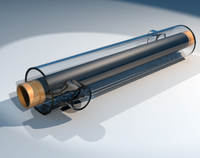
Photo from wikipedia
Abstract Supercapacitors require the use of electrode materials exhibiting high surface area, thermal and environmental stability, low cost and good conductivity. Asphaltene, an undesired and problematic fraction of crude oil… Click to show full abstract
Abstract Supercapacitors require the use of electrode materials exhibiting high surface area, thermal and environmental stability, low cost and good conductivity. Asphaltene, an undesired and problematic fraction of crude oil production, is one such cost-effective material that when activated, can provide desirable properties to be used in energy storage devices. In this work, a new and simple method to chemically activate asphaltene was designed using commercially available melamine sponges as a template to form an interconnected porous carbon network. The asphaltene derived carbon showed a surface area as high as 3868 m2g−1, and electrochemical capacitance in a standard aqueous electrolyte as high as 197.3F g−1 has been realized. After testing the asphaltene electrode-based supercapacitor device for 10,000 cycles, 89.9% of its capacitance was retained, indicating good stability for an energy storage device. Additionally, the use of asphaltene electrodes with “water-in-salt” electrolyte showed potential for higher voltage supercapacitors operating up to 2.5 V, with an energy density of 31Wh kg−1. These results suggest that what is currently considered an undesirable fraction of the crude oil, which has a tendency to deposit in wellbores, pipelines, and downstream facilities can be repurposed into a desirable material with remarkable properties for energy storage.
Journal Title: Fuel
Year Published: 2020
Link to full text (if available)
Share on Social Media: Sign Up to like & get
recommendations!